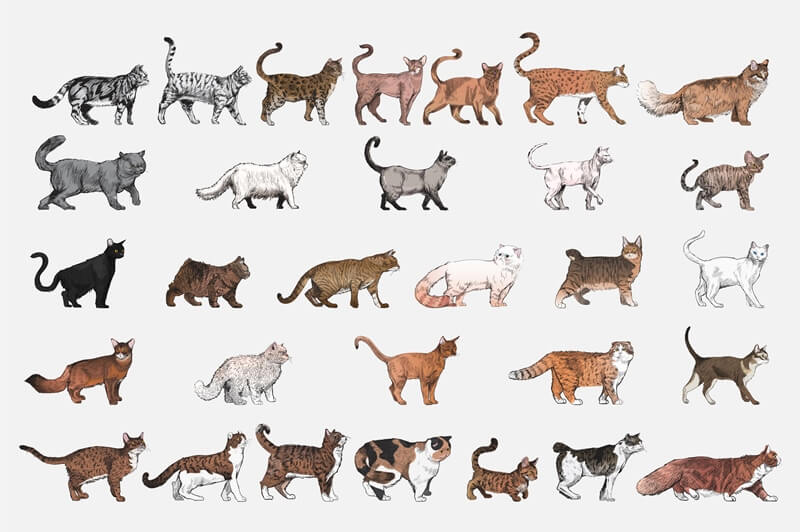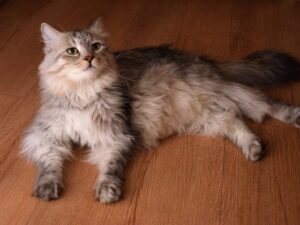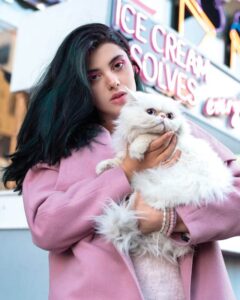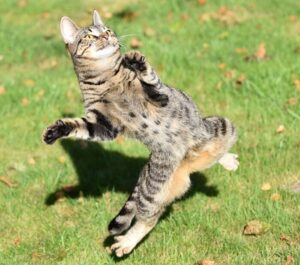As a veterinarian, I have gotten this question many times: Which cat breed would you recommend? That is not an easy question to answer. Cats are very complex, little creatures.

It is impossible to outline completely how to pick the correct one for you. I have attempted to provide you with an over of cat characteristics, and have you ask certain questions of yourself to find the companion of a lifetime.
Which Cat Breed, Color, Sex, and Age should You Choose?
Cat Breeds
The Cat Fancier’s Association lists 42 cat breeds that can be shown at competitions. We will briefly discuss some traits of the more common cat breeds.
The American Bobtail is a long-hair and very loving breed. It is a medium to large breed cat with a shortened tail. American Bobtail would be a good choice for wanting and sharing attention.
Balinese is a longhair, vocal, and active cat.
Bengals have soft, smooth shorthair that is a delight to touch. These large cats are very curious, intelligent, and athletic. They are known to be mischievous. It is not uncommon for a Bengal to escape from its kennel or house. They are sometimes too smart.
Birmans are sweet, patient, beautiful, intelligent, and long-hair. They are also known to be very trainable.
Bombays are soft thick short haired cats. They are known for playfulness and affection.
British Shorthair is a more calm and quiet breed.
Burmese, thick short-haired, are very fond of people and very affectionate. They make a great playmate.
Cornish Rex is known for their curly short hair. They tend to be active and fun-loving.
The Devon Rex is another curly short-haired cat that is often compared to a pixie.
Exotic Long-Hair and Exotic Short-Hair are quiet and affectionate.
Havana Brown is a beautiful chocolate brown cat known for being a busy-body and affectionate.
Japanese Bobtail is long or short haired bobtail. It is known for being active and intelligent.
Korat, short-haired cat, is a very energetic, affectionate feline.
Maine Coon, “gentle giant”, is a beautiful long and thick haired feline known for being large and rugged. They tend to be gentle and tolerable, but they can have their limits.
Manx is very short-tailed feline with higher rear legs. It is known for being almost dog-like with their quiet, gentle temperament.
Norwegian Forest Cat is a very large, long and thick-haired feline. It has the reputation of being a sweet, active cat.
Ocicat are beautiful short-haired cats. Ocicats are very active.
Oriental long and short haired felines tend to be very vocal and active.
Persian and Himalayans are long-haired, affectionate, and sometimes aloof. They are beautiful and tend know it.
Ragdoll and Ragmuffin are long-haired, laid back cats. They would make great lap cats and are tolerate being held by little humans. The signature move is being a rag (limp) when you hold them.
Russian Blues are known for their graceful play and beautiful short coat.
Scottish Fold is known for the short and folded ears with round face. They tend to be very laid back and sweet.
Siamese are the “talkers” of cats. They are very vocal and active.
The short-haired Singapura tends to be bossy and demanding.
The hairless Sphynx are active and affectionate.
Tonkinese, similar to Siamese, is very talkative and active.
Turkish Angoras are long-haired, busy, and curious.
These are only highlights into a few cat breeds. As one can see, their personalities can range greatly. Some are active while others are more laid back. All can be affectionate to their people, but some are known to be lap buddies.
Cat Color and Personality
Did you know the color of the cat can also predict its personality? Eighty percent of orange tabbies tend to be laid back male cats. Yes, males. The twenty percent of female orange tabbies can sometimes be more playful and have their limits.
The black cat has strong diverse personalities, but most are very playful. No black cat is the same. Cats with three colors are ninety percent female rulers. I say ruler, because they will eventually be the queen of the house.
These colors are your calico and tortoiseshell (including the torbie, aka a tortoiseshell tabby). They are female due to the colors being tied to the X-chromosome. These girls are strong willed and feisty.
Male Cat vs Female Cat
Male and female cats are different in their personalities as well. Feral males are very territorial and live with large number of female cats.
In domestic situations, we can still see territorial behavior (i.e. marking) but males tend to get along if both are neutered. Female cats tend to not be overly affectionate and can be aloof.
That being said; my female torbie cat is a LOVER. Female cats do tend to want to be the queen in domestic homes unlike feral colonies. They sometimes will not get along with other females. Don’t forget that female cats can mark as well.
Adult Cat or Kitten
Kittens are adorable, but they tend to be higher maintenance at first. Kittens need help in learning litter pan habits, eating habits, and just how to life. I always recommend waiting until a kitten is at least 8 weeks old before removing it from its mother.
This helps it to learn “how to cat” before you are in charge. While kittens may take more energy at first, they do adapt better and other cats are more likely to accept them over an adult. However, if you have a very geriatric animal, they may not appreciate a cute ball of fur running over them in middle of night.
What are Your Cat Needs?
So, what is best for you? Now, we need to look at you and your life. A cat needs to fit in well with your life to become that long-lost feline friend.
Cats and Kids
Do you have children? Very young children are best suited for a cat with laid back personality that still wants to play. Please be aware that toddlers can be more aggressive than the cat itself. A very tolerable, young adult cat may be safer for a toddler.
Grade school children would do well with a playful, active cat. Older children may want someone to cuddle up with during homework or movie. Assess your children or grandchildren before making that final decision.
Is Your House Ready for a New Cat?
Are other pets in the household? Will they be accepting of a new fur sibling? Sometimes we forget that it is not just about us. Dogs and cats can get along, but some dog breeds are notorious for chasing cats.
Your cat may want a friend or may want to be a single cat. So, set back and have a comprehensive look at your current fur baby. What do they want? Which cat breed will suit them best?
Cats and your Lifestyle
Is your lifestyle busy? Will you be home or away most of the time? If you are going to be away much of the time, you need an independent feline that will not stress if you are not there. You will want a cat that is not anxious with the constant going in the house.
Do you travel? Will your feline friend be staying or going? Cat that is staying needs to independent, people friend, and less anxious. You will want your cat to greet the caretaker with ease and comfort. If your feline is going to travel with you, you may want to find a more laid back feline that will tolerate long-rides or airplane flights.
Do you live a quiet life or retired? If you are not active and stay home, you may want a lap cat. So look into the more relaxed cat breeds to cuddle and rock.
Is there a Hypoallergenic Cat Breed?
Allergies? Hypoallergenic cat breeds do not truly exist. The allergen that makes people sneeze, skin reactions, etc is not from the hair. It is from the dander and saliva of the cat. Getting a short-haired or hairless cat is not going to prevent your allergies.
Some cats are known to make less of the offensive protein than others. These cat breeds include but not limited to: Balinese, Oriental shorthair, Devon Rex, Cornish Rex, Sphynx, and Siberian. Oh, did you know: male cats produce more of the protein than females and dark colors more than light colors?
Kittens tend to produce less, but they will eventually become an adult. Bathing does help reduce the allergen. Choose a shampoo that helps decrease the dander and remove the saliva. You will also want to have someone bathe your friend for you, and you will want to start baths as young as possible. Washing toys and beddings often help greatly as well.
The Commitment
You will be getting a 10-15+ year commitment. Are you ready financially and emotionally? Cats need a place of their own in the home, litter pan(s), litter, food, water, brushing, attention, etc.
Long-haired cats will need routine grooming more often than short-haired cats to prevent matting. (Short-haired cats still need brushing.)
Hairless cats will need extra care of their skin. Some cats will need you to monitor their food intake. Anxious cats may need you to make accommodations for them.
Cat Breeds and Genetic Disease
There have been some correlation with cat breeds and colors to certain medical conditions, but all cats can become ill. Maine coons and Norwegian Forest Cats are known for elbow and hip issues due to their large size.
Norwegian Forest Cat is also known for heart disease. Ragdolls are known for kidney and heart disease. Persians and Himalayans have a short nose and large eyes that can cause respiratory and eye issues. Cats with shortened tails tend to have large bowel disease. Large, overweight, male orange cats are known for getting urethral blockages from crystals or stones.
The more vocal, active cats can get cystitis/anxiety if they do not have enough to do. If you are purchasing from a cat breeder, some of these diseases can be tested for in the parents. Research the cat breed you choose to know which tests are recommended before purchasing a cat. Not all cat breeders will test for genetic diseases.
Are You Ready to Choose Your Feline Friend?
A cat can be a blessing in many ways. It is proven that people with pets do live longer and (I hope) happier lives than those without pets. Making the decision of which cat and cat breed is right for you is tough. Please research the cat breed, cat color, and your lifestyle. I hope that I have provided you with a good start on what to look for in your research.
Last and most important tip: It is always very important to have one or more visits with your possible adoptee or adoptee’s parents. It is during these times that you will get a true feeling of who they are. Each cat is different and not all fit within the stereotypes of their breed, color, or sex.
More Information on Cat Breeds and Selecting your Feline Friend
- Cat fanciers association: https://cfa.org
- American Veterinary Medical Association: https://www.avma.org/resources/pet-owners/petcare/selecting-pet-cat
- Petfinder: https://www.petfinder.com/pet-adoption/cat-adoption/cat-adoption-tips
- Cornell Feline Health Center: https://www.vet.cornell.edu/departments-centers-and-institutes/cornell-feline-health-center/health-information/feline-health-topics/choosing-and-caring-your-new-cat



